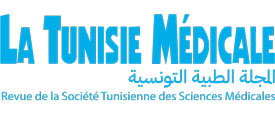Sommeil du sujet âgé consultant en première ligne : A propos de 50 cas
##plugins.themes.academic_pro.article.main##
Résumé
Pré-requis: Les troubles du sommeil du sujet âgé sont assez fréquents. Néanmoins, ils sont souvent sous diagnostiqués et mal pris en charge.
But : Etudier les caractéristiques du sommeil chez le sujet âgé consultant en première ligne.
Méthodes : Une enquête transversale a été réalisée sur un échantillon aléatoire de cinquante sujets âgés de 65 ans et plus consultant dans le centre de santé de base d’Ezzahra et dans un cabinet privé de la même délégation.
Résultats : L’indice d’efficacité du sommeil était de 0,85. Les réveils nocturnes étaient présents chez 44 sujets (88%). L’insomnie inexpliquée de fin de nuit a été rapportée par 19 sujets (38%). Parmi les sujets enquêtés, 40 (80%) ont été considérés comme ayant au moins un trouble du sommeil. La plainte insomnie était présente chez 35 sujets (70%). La somnolence diurne excessive et/ou hypersomnie étaient présentes chez 70% des sujets. Des ronflements nocturnes ont été rapportés par 22 sujets (44%). Neuf sujets (18%) présentaient des pauses respiratoires au cours de leur sommeil. Malgré la grande fréquence des troubles du sommeil chez les sujets enquêtés, seulement 6 sujets parmi eux (15%) ont consulté leur médecin traitant pour ce motif. Parmi les patients ayant un trouble du sommeil, 14 sujets (35%) prenaient des hypnotiques dont 6 (43%) par automédication.
Conclusion : Les troubles du sommeil chez le sujet âgé ainsi que l’automédication par les hypnotiques sont fréquents et sousdiagnostiqués. Ils devraient être systématiquement recherchés en consultation de première ligne.
But : Etudier les caractéristiques du sommeil chez le sujet âgé consultant en première ligne.
Méthodes : Une enquête transversale a été réalisée sur un échantillon aléatoire de cinquante sujets âgés de 65 ans et plus consultant dans le centre de santé de base d’Ezzahra et dans un cabinet privé de la même délégation.
Résultats : L’indice d’efficacité du sommeil était de 0,85. Les réveils nocturnes étaient présents chez 44 sujets (88%). L’insomnie inexpliquée de fin de nuit a été rapportée par 19 sujets (38%). Parmi les sujets enquêtés, 40 (80%) ont été considérés comme ayant au moins un trouble du sommeil. La plainte insomnie était présente chez 35 sujets (70%). La somnolence diurne excessive et/ou hypersomnie étaient présentes chez 70% des sujets. Des ronflements nocturnes ont été rapportés par 22 sujets (44%). Neuf sujets (18%) présentaient des pauses respiratoires au cours de leur sommeil. Malgré la grande fréquence des troubles du sommeil chez les sujets enquêtés, seulement 6 sujets parmi eux (15%) ont consulté leur médecin traitant pour ce motif. Parmi les patients ayant un trouble du sommeil, 14 sujets (35%) prenaient des hypnotiques dont 6 (43%) par automédication.
Conclusion : Les troubles du sommeil chez le sujet âgé ainsi que l’automédication par les hypnotiques sont fréquents et sousdiagnostiqués. Ils devraient être systématiquement recherchés en consultation de première ligne.
Mots-clés :
sommeil, troubles du sommeil, sujet âgé, enquête, vieillissement.##plugins.themes.academic_pro.article.details##
Références
- Pringuey D. Les troubles du sommeil chez le sujet âgé. In sommeil et pathologie de l'encéphale. Paris:Masson,1990:170- 90.
- Montemayor T. Sommeil du sujet âgé : évolution, troubles et prise en charge. Médecine du sommeil 2008; 5:5-9.
- Buysse DJ, Chair MD. The international classification of sleep disorders, Revised diagnostic and coding Manual February. New York: Library of Congress Catalog,1997:15-24.
- Parola SR. Questionnaire du sommeil. J. Sleep Research 1998:7.
- Groulx B. Troubles du sommeil chez la personne âgée et leur traitement. L'actualité médicale 1999;7:3-8.
- Meslier N, Vol S, Balkau B et al. Prévalence des symptômes du syndrome d'apnées du sommeil. Etude dans une population française d'âge moyen. Rev Mal Respir 2007;24:305-13.
- Onen F. Insomnie du sujet âgé .Médecine du sommeil 2005;2:11-6.
- Lorrain D. Sommeil, détresse psychologique et vieillissement. Can Fam Physician 2005;48:748-65.
- Fichten CS, Libman E. L'insomnie et son traitement chez les personnes âgées : une nouvelle approche. Santé mentale au Québec 1991;16:99-116.
- Blaïs FC, Morin CM, Boisclair A, Grenier V, Guay B. L'insomnie, prévalence et traitement chez les patients consultant en médecine générale. Can Fam Physician 2001;47:759-67.
- Kamel NS, Gammack JK. Insomnnia in the elderly: cause approach and treatement. Am J Med 2006;119:463-9.
- Blaïn H, Dauvilliers Y. Les troubles du sommeil fréquemment observés chez le sujet âgé. NPG, 2010;55:6-13.
- Bliwise DL, Foley DJ, Vitiello MV et al. Nocturia and disturbed sleep in the elderly. Sleep Medicine 2009;10: 540-8.
- Shapiro CM. Syndrome d'apnées / hypopnées du sommeil et le ronflement. In : Shapiro CM. ABC des troubles du sommeil. Paris Maloine 1996:51-9.
- Swift CG, Shapiro CM. Sommeil et problèmes de sommeil des personnes âgées. In : Shapiro CM. ABC des troubles du sommeil. Pais Maloine 1996:95-103.
- Nguyen VH, Ourabah Z, Sebban C. Quand faut-il explorer le sommeil chez la personne âgée? Médecine du sommeil 2008;5: 36-40.
- Belanger L, Vallières A, Morin CM. Insomnie et utilisation accrue de somnifères chez les aînés. Can Fam Physician 2006;52:968-73.
